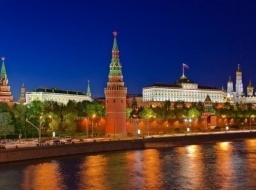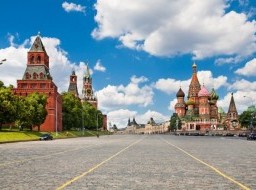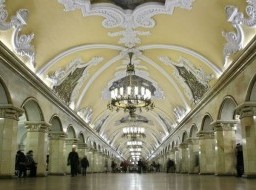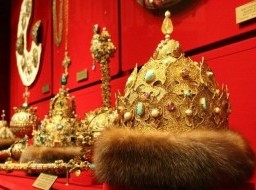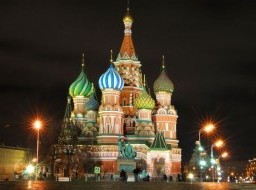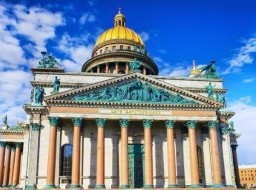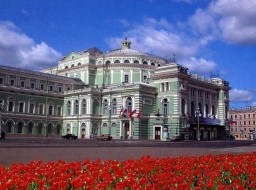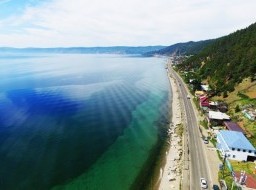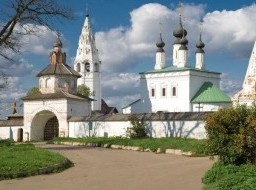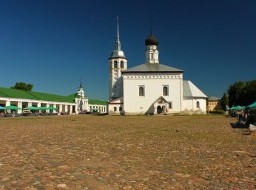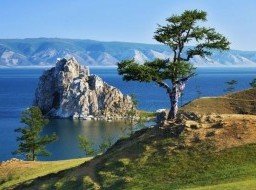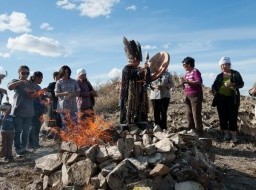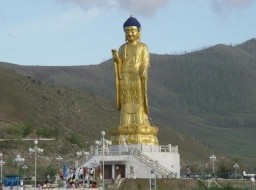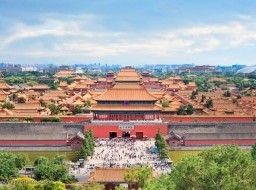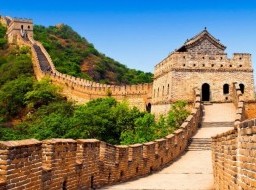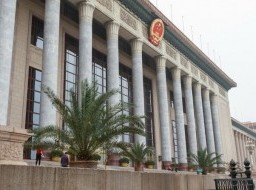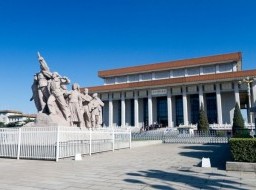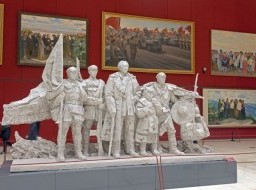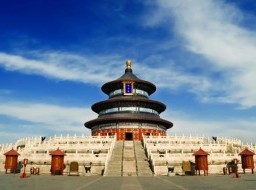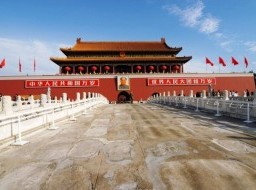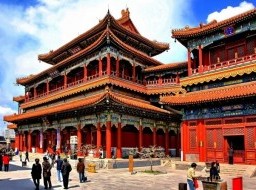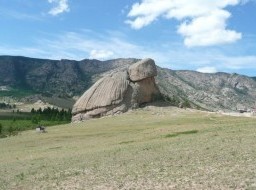Trans-Mongolian Express, Eastbound
Your adventure begins with two days in St Petersburg before travelling to Suzdal in Russia’s Golden Ring, a beautiful old town where you can share a meal with our local friends here and have a go at cooking pastries with the family. Next, explore Moscow before beginning your journey on the Trans-Siberian Railway. Admire the scenery as you head towards Irkutsk, jumping off point for the massive and magnificent Lake Baikal and your stay with a friendly, local Buryat family. Here, you can freshen up after your long journey with a traditional Russian banya – a refreshing steam, wash and birch branch ‘massage’.
From here, you’ll be travelling on the Trans-Mongolia Railway, heading into Mongolia. In the wilderness here, you’ll stay overnight in a tourist ger camp and learn more about the country’s culture and heritage, seeing its original Buddhist temple and the city built by Genghis Khan. This unforgettable journey ends in Beijing, where you can learn about China’s long history and contemporary life. If you have time, take the option to extend your stay here for a few extra days, so you can explore the Forbidden City, take a cycling tour or perhaps visit the Great Wall.
Itinerary Hide all details
Zdrastvutye! Welcome to Russia. Your adventure begins with a Welcome Meeting at 6pm today, where your insurance and next of kin details will be collected. Please also have two copies of your passport, visa and migration cards ready. Your leader will collect one; the other is for you to keep on you at all times whilst on the trip. Truly one of Europe's finest cities – baroque European architecture combined with the opulent palaces of Russian royalty – St Petersburg was built by the Russian tsar Peter the Great and his legacy will clearly be felt as you explore its enigmatic streets and visit its showcase palaces and museums.
Built on 42 islands, St Petersburg is also known as the ‘Venice of the North’. Spend the day exploring the city on foot and using the great public transport, crossing its many rivers and canals. Perhaps enjoy incredible views across the city from the colonnade at St Isaac’s Cathedral, or walk along Nevsky Prospekt, St Petersburg’s main street. Head down to Aleksandr Nevsky Lavra where Russia's great musicians and writers like Tchaikovsky and Dostoyevsky are laid to rest in the cemetery or visit Peter the Great’s ghoulish collection of curiosities at the Kunstamera. The Hermitage Museum is one of the largest and oldest museums in the world with one of the world's premier art collections housed in this former imperial Winter Palace. A whole day could easily be spent wandering its halls. Whatever you choose, the city is easy to get around and your leader can help you make the most of your free day.
Before the overnight train this evening, perhaps try your hand at a Matryoshka Doll painting workshop or catch a matinee show at the famous Mariinsky Theatre. This evening, head to the railway station by public transport to take your first overnight train to Vladimir (approximately 11 hours). It’s recommended to bring some food with you for dinner in your compartment, before getting an early night. This is the only daily direct train to Vladimir and you’ll arrive at your destination at the crack of dawn. Trains on this journey are simple but comfortable. You’ll travel 2nd class on this trip. There's a toilet/bathroom at the end of each carriage with a small sink and cold water. An attendant is assigned to every carriage to look after your comfort and safety (although service standards can vary greatly). Each compartment has four bunks with luggage storage space inside. Bedding is provided, although some travellers still prefer to bring their own sleeping sheet. There's hot water available for making drinks or instant meals, tea and coffee. Sometimes snacks and drinks are available for purchase on board and most trains also have a dining car, although with a limited menu. Trains are generally heated but most do not offer air conditioning. The train can become very hot even in winter and the train attendants will not allow the windows to be opened, please pack clothing appropriate for the warmer conditions on these train journeys. A brief word about drinking on the train: Social drinking is common on trains in Russia and can be an enjoyable way to meet local people as well as interact with your fellow travellers (in moderation). While alcohol is often available for purchase on the train, spirits (including vodka) should only be consumed in the dining car. While we certainly want all our travellers to have a great holiday it's important that you show due respect for your fellow group members, and keep in mind that many of your local companions use the train as a means of transport to get home or to work.
Arrive in Vladimir very early this morning and transfer by private minivan to Suzdal (approximately 30 minutes). The town is a main stop on Russia’s legendary Golden Ring, the circle of ancient and former capitals that played an important part in the formation of the Russian Orthodox Church and that hold the memories of significant events in Russian history. The fairytale-feel historic small town of Suzdal is filled with contrasting examples of early Russian architecture, where onion-domed monasteries stand next to lovingly decorated wooden cottages. Take in the sights – the grandeur of the Kremlin, the carved stonework of the Cathedral of the Nativity, the trading square, market and monasteries (approximately 3 hours total). Today you’ll also have a chance to try hearty home cooking at the home at one of our local friends for lunch or dinner.
Transfer back to Moscow by private van (approximately 4 hours). The great city of Moscow has survived centuries of revolution and seen Russia through some of its most turbulent years, from the days of the tsars through the communist era to the growing pains of democracy. Beneath its modern veneer, a sign of Russia's recent embrace of capitalism, Moscow is a fascinating, historic city with a wealth of sights to see. In your free time in today you could step inside the colourful St Basil's Cathedral on Red Square. Legend has it that tsar, Ivan the Terrible, had the two architects blinded so that they couldn't again build anything as beautiful. Otherwise you might travel back to the beginnings of Russian art at the Tretyakov Gallery or join on of our Urban Adventure tours.
Visit the mausoleum of Russia’s most famous revolutionary – Lenin. He was the initiator of the 1917 Russian revolution that ushered in the era of communism, and you will join the sometimes long queue lining up to visit his austere eternal resting place on Red Square. Then enter the Kremlin grounds with a local guide, home to the oldest and most important churches in the country, and where many Tsars and Tsarinas are laid to rest. Walk through the soaring towers and cathedrals of the political and spiritual heart of Russia before entering the Armoury Museum, home to an eye-bulging former royal collection of ambassadorial gifts, Faberge eggs, coronation robes and glittering jewels. Afterwards perhaps take the metro to see elaborately decorated stations unlike any other. From sculptures depicting the glory of the soviet days to ornate chandeliers and stained glass windows, these are the 'Palaces of the People'.
Take the metro to Yaroslavsky Station, the starting point of your epic journey on the Trans-Siberian Railway. It’s a 3-day, 4-night trip to Irkutsk (approximately 90 hours). There is only one daily train between Moscow and Irkutsk that has a total travel time of less than 100 hours and departs at a convenient time from Moscow. Some foreign travel companies that have less regular departures than us may take the train that departs late evening, however this train only departs every second day. In order to ensure that this trip can always run on the same itinerary, we take the daily train that leaves during the day. The downside of this is that we only have a limited time in Moscow, so you will need to plan carefully to fit as much in as possible. The upside is that this train has fewer foreign tourists on board and gives you much more of a chance to interact with regular Russian travellers. Life on the train will pretty much consist of eating, drinking, talking, reading, sleeping and gazing out the window. Settle into the rhythm and enjoy the simplicity of having very little to do. Pro tip: buy dill and parsley from the station sellers along the way to freshen up your soups and other meals!
Your long rail journey finally brings you to the Siberian city of Irkutsk, gateway to Lake Baikal – the largest freshwater lake in the world. Drive direct from the train station to a lakeside village by private minivan (approximately 2 hours). Bolshoye Goloustnoye sits in the delta of the Goloustnoye River on the western edge of Lake Baikal. Here you’ll be hosted by some of the kindest and most hospitable people around – our lovely local Buryat (the ethnic group of the Lake Baikal area) friends in their guest house and home. Accommodation is basic and multi share, with no running water and outside toilets, but cosy and comfortable. Situated right in the centre of the village, you'll certainly get to experience typical Russian rural life here. Slough away the grit of your long train journey in the family's backyard banya, the Russian version of a sauna. Locals swear by the cleansing, healing and meditative properties of having a steam and a wash in the banya, and it can also be quite the social occasion! Make sure to avail yourself of some birch twigs and slap yourself (and others!) over the shoulders for a traditional Siberian 'massage' to get the true banya experience.
Enjoy your surroundings today explore the beautiful Baikal nature. There are options for swimming in the lake or river, or taking a boat trip along the shore. You can take a short hike up a nearby mountain for epic views of the lake and the village, then hire some bikes to explore further afield. The lake is so flat that you may hardly be able to make out the horizon in the distance. In the village cows roam freely, contained only by the fences keeping them out of the village's produce gardens. The houses themselves are bright examples of 'Siberian Lace' – decorative carved wooden window fixtures that keep evil spirits from entering homes. Each day you’ll be treated to delicious, hearty Siberian home cooking, all made from fresh local produce.
Return to Irkutsk today (approximately 2 hours). Once a boom town of exiles and gold merchants, Irkutsk suffered under a regime that brought Soviet architecture and communist propaganda to its streets. Fortunately, the sophisticated atmosphere it once offered is not totally lost, and Irkutsk remains a fascinating city. Some parts of town are still lined with traditional houses and the old homes of liberal aristocrats exiled from Moscow early in the 19th century. Visit the House Museum of Maria Volkonskaya. Sometimes called the Princess of Siberia, Maria was one of the many Decembrist revolutionaries' wives who voluntarily accompanied their husbands into exile. The house is still filled with many of her personal items and visitors can get a sense of how she must have felt, a young aristocratic woman banished to depths of Siberia. Walking through the city, see some of the original wooden residences and stop off at the Central Market to taste some of the amazing range of local produce for sale and to stock up on supplies for our next journey. Then it is back on the rails as we travel the Trans-Mongolian Railway for a two-night train trip (approximately 40 hours) into Mongolia. During the journey you’ll cross the border from Russia (Naushki) into Mongolia (Sukhbaatar). There's a long wait at the border towns while passports are processed, customs does their checks and we wait for the engine to rejoin the train. It can sometimes be a long, hot and frustrating day, so a healthy dose of patience and understanding is recommended. After everything is finally completed, you’ll be rewarded with the magical landscapes of Mongolia.
Crammed between the superpowers of Russia and China, the independent nation of Mongolia is a truly adventurous destination. The capital, Ulaanbaatar (affectionately known as UB), is a city where you’ll find elderly Mongolians in traditional dress, business suit-clad entrepreneurs and young monks. After checking in to our hotel, venture out into the city, where the close relationship with the USSR is evident in the Soviet style architecture. Perhaps explore one of the city's many museums to learn about the country's turbulent history, including the reign of the most famous of Mongolian historical figures – the feared and respected Genghis Khan. As more and more traditionally nomadic Mongolians are moving to the city in hope of a better life, they bring with them their traditional lifestyle of living in gers, and so UB is surrounded by a growing number of such ‘ger districts’. Life here is hard, with high unemployment and little access to facilities such as electricity and running water. Together with local guide you'll visit one such district located in Northern outskirts of the city, where you’ll meet some of the residents, have a cup of traditional Mongolian tea and a chat about life in an urban ger community.
Travel to Terelj National Park by private van (approximately 90 minutes). With rolling meadows dotted with munching yaks, forested hills, and imposing rock formations, this is the perfect place to take in Mongolia's natural beauty. A local guide will share some insight into Mongolian customs and culture with you, as well as lead you on a hike to a local Buddhist retreat. In Terelj, you’ll stay in a holiday ger camp (multi-share) with full board. Vegetarians can be catered for, although choices may be limited – please let us know if you have any specific dietary requirements at time of booking. The gers sleep up to four people with comfy beds and plenty of blankets. In the colder months you might want to stoke up the stove in the centre of the ger – you'll be toasty warm in no time! You’ll share meals together in the dining quarters. Bathroom facilities here are basic with no showers, but there are toilets and basins with cold water in a support building outside. Please note in the colder months when plumbing is no longer functional there will be no running water and an outdoor pit toilet will be used. Tonight, get involved in making your own dinner by learning to cook buuz – traditional Mongolian dumplings! Then take in the wonderful views across the gers and rocky escarpment as you experience a memorable Mongolian sunset.
Return to the hotel in Ulaanbaatar today (approximately 1.5 hours). On the way back to UB, stop and visit the huge Genghis Khan Monument. Genghis Khan, the legendary horseman who conquered half the known world in the 13th century, can be viewed from miles away. You can climb up the structure and see the view from atop the horse, maybe a little tacky but also pretty amazing. For the rest of your free time in UB you can explore the city, perhaps experience Mongolia's rich artistic culture at a performance of traditional throat and ‘long song’ singers, musicians, dancers and contortionists. Maybe visit Mongolia’s largest and most important active monastery, the lively Gandan Khiid, to learn about the main religion of Mongolia – Tibetan Buddhism. Perhaps look out over Ulaanbaatar from the top of Zaisan Hill, or visit one of the city’s fascinating museums. At the Intellectual Museum you can learn about the history and culture of this intriguing country through puzzles, toys and magic tricks.
Farewell Mongolia today as you travel from Mongolia to Beijing, the next part of your epic train ride. The overnight journey (approximately 30 hours) leaves early in the morning and includes a long stop at the Mongolia-China border where the train changes bogies (wheels) due to the different rail gauges. The train may have a basic restaurant car but it's advisable to stock up at the supermarket before leaving Ulaanbaatar. Say goodbye to the relative time warp of Mongolia, get comfortable and watch the scenery change from rolling green meadows to rocky desert, to the built-up modernity of the city.
Arrive in Beijing and transfer to your hotel. The capital of the most populous country on earth, Beijing is quickly shedding its historical face in favour of modernity. However, there are still plenty of places to go that will give you a great insight into the nation's ancient past, as well as sights that showcase China's contemporary culture. After a quick freshen up at the hotel, get out onto the streets of Beijing. Perhaps head to Tian'anmen Square – the symbolic centre of Chinese power. Framed by the Gate of Heavenly Peace with its Mao portrait, Mao's Mausoleum, the Great Hall of the People, and the National Museum, it's a place of pilgrimage for the Chinese tourists who consider it the heart of their nation. Here you can enter the imposing Forbidden City, former home to China's imperial rulers and filled with palaces, gardens and seemingly never-ending grand courtyards. There's so much to see and do in Beijing that staying an extra few days is highly recommended. In this extra time you could take a tour to the Great Wall, cycle around the city, visit the park surrounding the Temple of Heaven, or explore the beautiful Tibetan-style monastery of Yonghegong (the Lama Temple). Beijing is vast and overflowing with sights – with your hotel located centrally, a walk in any direction will unveil all sorts of wonderful surprises.
There are no activities planned for the final day and you are able to depart the accommodation at any time. There's so much to see and do in Beijing that we highly recommend staying an extra few days.
What's included
- accommodation
- tour leader
- transfers
- listed activities
Single supplement $475
Some roads are rough and winding - don't forget your meds if your prone to travel sickness.
ACTIVITY LEVEL: Moderate.
Single rooms available at hotels only for a surcharge.
Price
| Price package | Price per person | |
|---|---|---|
08 Apr 2019Price per person | Book now | |
22 Apr 2019Price per person | Book now | |
06 May 2019Price per person | Book now | |
13 May 2019Price per person | Book now | |
20 May 2019Price per person | Book now | |
03 Jun 2019Price per person | Book now | |
17 Jun 2019Price per person | Book now | |
08 Jul 2019Price per person | Book now | |
22 Jul 2019Price per person | Book now | |
29 Jul 2019Price per person | Book now | |
05 Aug 2019Price per person | Book now | |
12 Aug 2019Price per person | Book now | |
19 Aug 2019Price per person | Book now | |
26 Aug 2019Price per person | Book now | |
02 Sep 2019Price per person | Book now | |
09 Sep 2019Price per person | Book now | |
23 Sep 2019Price per person | Book now | |
30 Sep 2019Price per person | Book now | |
07 Oct 2019Price per person | Book now | |
14 Oct 2019Price per person | Book now | |
06 Apr 2020Price per person | Book now | |
20 Apr 2020Price per person | Book now | |
04 May 2020Price per person | Book now | |
11 May 2020Price per person | Book now | |
18 May 2020Price per person | Book now | |
01 Jun 2020Price per person | Book now | |
15 Jun 2020Price per person | Book now | |
06 Jul 2020Price per person | Book now | |
20 Jul 2020Price per person | Book now | |
27 Jul 2020Price per person | Book now | |
10 Aug 2020Price per person | Book now | |
17 Aug 2020Price per person | Book now | |
24 Aug 2020Price per person | Book now | |
31 Aug 2020Price per person | Book now | |
07 Sep 2020Price per person | Book now | |
14 Sep 2020Price per person | Book now | |
21 Sep 2020Price per person | Book now | |
28 Sep 2020Price per person | Book now | |
05 Oct 2020Price per person | Book now | |
12 Oct 2020Price per person | Book now | |
14 Dec 2020Price per person | Book now |
Tour Reservation
Ready to buy? To complete your purchase, please select travel dates, travelers and click Purchase button.
Contact us
Just browsing or have a question? We will be happy to assist! Send a message to one of our awesome destination specialists.
Email usJust browsing or have a question? We will be happy to assist! Send a message to one of our awesome destination specialists.
Back to bookingVisa
Russian visa support (Russian visa invitation letter) is included.
Sights included in program
Thanks ! We will reply you in less than 24 hours (usually within 1-2 hours).
Thanks ! We will reply you in less than 24 hours (usually within 1-2 hours).
Our flexible payment options allow you to pay 20% of a deposit first and the remaining 80% in 14 days prior to your tour date - payment can be done both online or over the phone. This gives you the peace of mind knowing your spaces are booked on the tours and that you do not miss out on making the most of your time in Russia.
Also you get the best, top-rated and most experienced and knowledgeable hand-picked tour guide appointed on a priority basis.
In our experience, exceptional travel experiences are almost always delivered by exceptional people. With that in mind, we utilize a comprehensive approach to select and employ the best tour guides only. Multilingual and well travelled, each possesses deep insight into the diverse attractions and cultural patterns throughout the region. With us guides undergo a rigorous selection process, achieving outstanding knowledge of local culture and language. Rest assured that the best tour guides only will be working on the tours to give you excellent opportunity to explore the best of the sights during both short and long-term stay in Russia.
Speak to an expert
Call us now
+1 (888) 845-8877
- Home
- |
- Tours
- |
- Day tours
- |
- Rail tours
- |
- Shore excursions
- |
- My trip
- |
- About
Group Tour Packages
Company Information
US office
3422 Old Capitol Trail Suite 1252,
Wilmington DE, 19808 USA.
US toll-free: 1-888-845-8877
Russian office
Ligovsky pr. 57, Office 19,
191040, St. Petersburg, Russia
tel: +7-812-309-5339
© 2001 – 2024 by Northern Crown, Ltd. uVisitRussia and uVisitRussia.com are registered trademarks. Terms & Conditions Privacy Policy
Why Do You Need Our Travel Expert
Contact our experts, and they will help you to plan your best trip to Russia, with attention to every detail!
Our Experts have been in the travel industry for many years, guarantee to offer first class customer service, excellent value for money and unbiased advice. They are standing by to find and build your dream holiday to one of the world's most fascinating destinations - Russia.
Your personal Travel Expert will guide you through each stage of the travel process, from choosing a program that fits you best to support during your trip.
Just tell us your e-mail, and we'll take care of everything!
Ask a Travel Expert 
Leave your phone number
Your tour request has been received. Thank you !
We have sent you the confirmation message to [email]
Please make sure that you receive this message (sometimes e-mail messages may go to the spam/junk mail).
If you did not get this message, it means you will not get message with the tours' selection as well. If you use a Yahoo!, Gmail, AOL or Hotmail, we recommend to add request@uvisitrussia.com to your address book.
We recommend to leave your phone number. If we will not heard back that you received the e-mail with the tours' selection, we will contact you by phone.
And you will not miss the best tour for you.
Thank you ! Your request for Travel Expert assistance has been sent. We will e-mail you within 1 hour.

